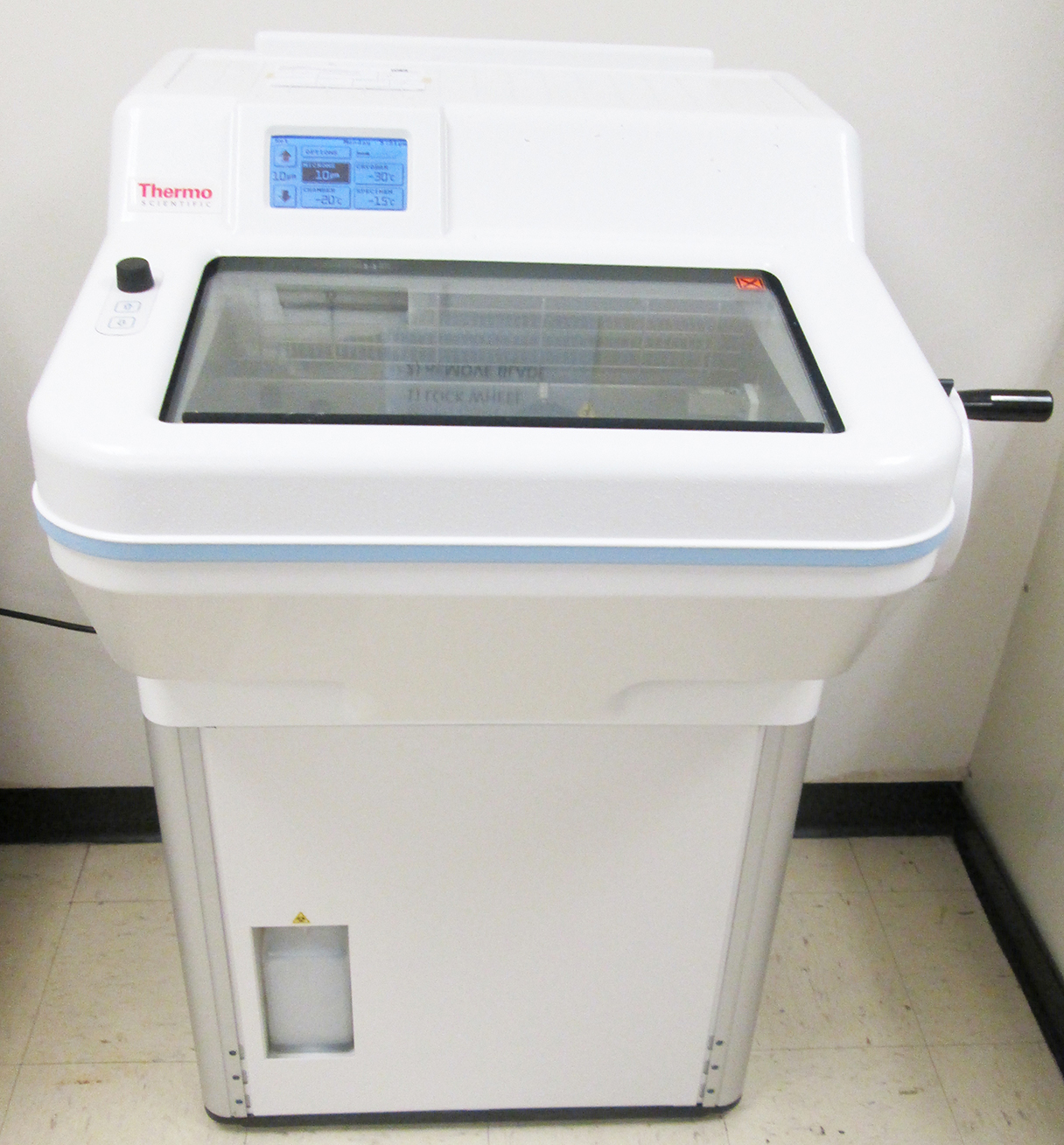What is a Cryostat?
 Similar to a standard microtome, a cryostat functions to obtain thin (1-10 mm in thickness)
sections from a piece of tissue, but while a standard microtome carries the operation
at room temperature, the cryostat enables the operator to section the tissue at low
temperature (–20 to –30 C). In a cryostat, the blade and the sample are located inside
an upright stationary freezer/chamber while the wheel for rotating the sample holder
is externally located.
Similar to a standard microtome, a cryostat functions to obtain thin (1-10 mm in thickness)
sections from a piece of tissue, but while a standard microtome carries the operation
at room temperature, the cryostat enables the operator to section the tissue at low
temperature (–20 to –30 C). In a cryostat, the blade and the sample are located inside
an upright stationary freezer/chamber while the wheel for rotating the sample holder
is externally located.
Tissues for cryostat sectioning do not need be fixed in formalin for hours or days, as is the case for routine histology. Instead, tissues are immediately cryofixed after sampling. For cryofixation, the tissue pieces are placed in a viscous, gel-like medium (OCT) and are plunged in isopentane cooled with dry ice or liquid nitrogen.
For sectioning, the frozen OCT tissue blocks are placed on a metal plate which brings their temperature to –20 to –30 C. Once that temperature is reached, the specimen is mounted on the microtome chuck and sectioned. Once sections of a satisfactory quality are obtained, they are mounted on a glass slide at room temperature (~20 C). The higher temperature of the glass slide relative to that of the tissue section causes the section to instantaneously melt and adhere to the glass.
The entire process from cryofixation to obtaining sections on glass slides can take as little as 10 to 20 minutes, allowing for rapid sample analysis.
Applications
Cryostat sectioning offers two main advantages over standard histology microtome sectioning. First, the turnaround time from fixation to tissue section is much shorter. Second, protein antigenicity is better preserved and therefore cryostat sections are well suited for immunofluorescence staining of multiple proteins in the same tissue section.
The disadvantage of cryostat sectioning over standard histology microtome sectioning is that the cytological features of hematoxylin-eosin (H&E) stained paraffin embedded tissue sections are superior to those of H&E stained cryostat sections. This is because ice crystals may form during the cryofixation process which will distort the cytoarchitecture. In addition, cryofixed tissues embedded in OCT tend to freeze-dry and ideally should be sectioned immediately after cryofixation or stored under conditions that minimize freeze drying.
Specifications of the Shandon FE Cryostat
- Touch screen display for setting up sectioning parameters
- Section thickness adjustment 1-20 μm in 1μm adjustments and 20–60 μm in 5μm adjustments
- Vertical cutting stroke 57mm
- Horizontal specimen advance of 25 mm
- Cryochamber temperature control 0° to -35°C
- Cryobar and dedicated adjustable cryobar cooling system to -55°C. The cryobar refrigeration
system cools specimen in as little as two hours while preventing freezing
- Specimen holder temperature control 0° to 40°C (±10° of chamber temperature)
- Positive locking flywheel to prevent injury while working around blade and specimen
- Automatic fumigation cycle to disinfect chamber
- Uses CFC-free refrigerants and foam insulation
- Dual compressor system to ensure specimen integrity by keeping specimens frozen if
the cryobar fails
- Ergonomic design including a three-level adjustable footrest to help reduce fatigue while sitting or standing and a raised cutting area to help prevent back strain while sectioning
